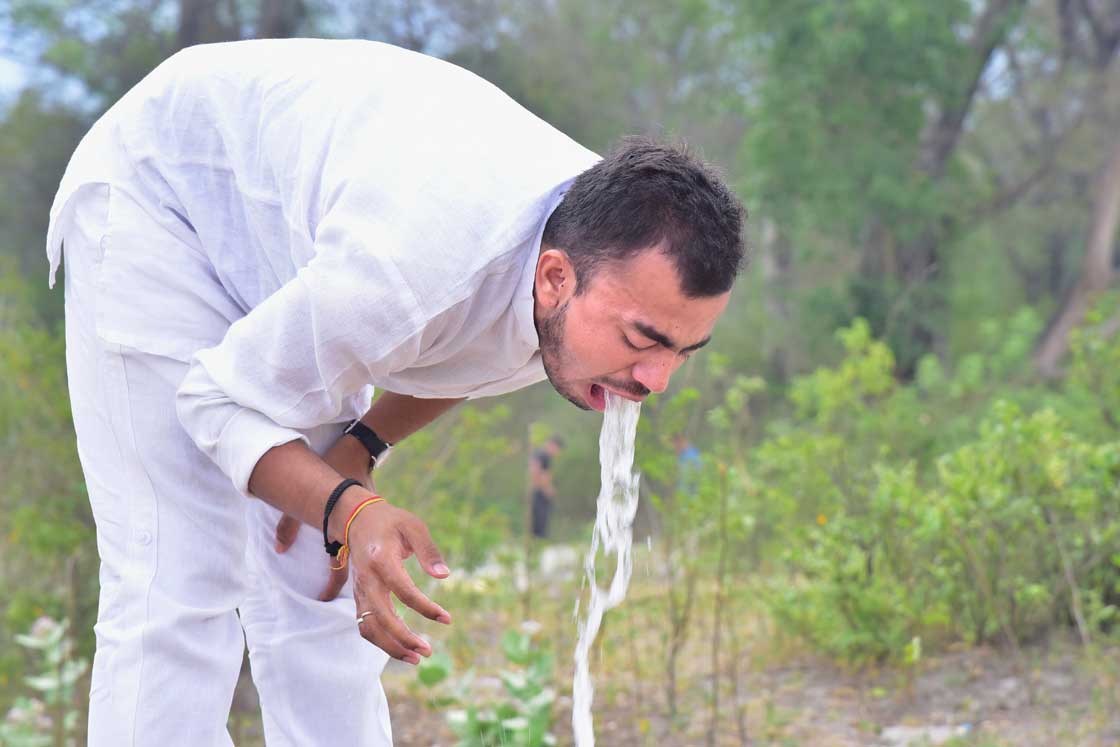
Dhauti
- March 4, 2021
- Posted by Dr. Vaidya Karanvir Singh
- 0 Comment(s)
A series of cleansing techniques which are mainly divided into three groups:
Antar dhauti (internal cleansing)
Sirsha dhauti (head cleansing or danta dhauti)
Hrid dhauti (thoracic cleansing)
The internal techniques clean the entire alimentary canal overall from the mouth to the anus. These are mainly divided into 4:
- Shankhaprakshalana (varisara dhauti) and laghoo shankhaprakshalan – cleansing of intestines.
- Agnisar kriya (vahnisara dhauti) – activating the digestive fire.
- Kunjal (vaman dhauti) – Cleansing the stomach with water.
- Vatsara dhauti – Cleansing the intestines with air.
Table of Contents
Shankhaprakshalana:
Preparation:
It is advisable to take a light meal or semi-liquid meal the night before undertaking this practice. Plenty of clean, warm water should be available. Add 2 teaspoons of rock salt as per litre to the water.
Intestinal Wash:
Drink 2 glasses of lukewarm water as quickly as possible .Perform the following five asanas dynamically, 8 times each in given sequence:
- Tadasana
- Tiryaka Tadaasana
- Kati chakraasana
- Tiryaka bhujangaasana
- Udarakarshana.
This is one complete round .Do not rest in between rounds.
Drink 2 glasses of salty warm water and again repeat the five asanas eight times each.
Repeat this process a third time then go to the toilet and see if there is any movement in the bowels. Do not strain .After a few minutes or so, come out, regardless of whether there has been any movement in the bowels or not; it is not essential at this point.
Drink two more glasses of warm and salty water, repeat 5 asanas eight times each. Again go to the toilet and see if there is any movement in the bowels and do not force to produce bowel movement.
Continue drinking the water, performing the asanas, going to the toilet when pressure builds up. Spend a little time in the toilet as possible, a minute or so is enough. The aim is to build up the internal cleansing pressure. At first solid stool will be evacuated followed by a mixture of stool and water .As the practice progresses more water and less solid stool will be excreted .Eventually cloudy yellow and , finally, almost clear water will be evacuated .
Sixteen glasses are generally required before perfectly clean water is evacuated (depends on person to person).
Special meal and rest:
Total rest is essential .Lie down in shavaasna for 45 minutes, but do not sleep as a headache or cold may result. It is important to keep body warm .Passing urine at this time is perfectly normal.
Exactly after 45 minutes specially prepared food, khicheri with ghee, must be taken .A sufficient amount of khicheri must be eaten to reline the intestines and keep the walls of the gut stretched, otherwise you may cramp due to the absence of bulk to which they are accustomed .This bulk aids the intestines to resume peristalsis.
Complete rest should be taken for the entire day and also the following day .Khicheri should also be prepared for the late afternoon or evening meal, about six hours after the first special meal. The stomach must be filled to the capacity at both meals, even if there is no feeling of hunger.
Frequency:
This practice should not be performed more than two times a year.
Food restrictions:
For at least one month after the practice, all chemically processed or packed food, pungent, acidic, spicy, rich and non-vegetarian foods must be exclusively avoided .No pickles (excess salt and preservative present), sweets, chocolates, ice cream or soft drinks should be taken. Milk, buttermilk, yoghurt and all sour fruits, especially acidic fruits such as lemons, grapefruit, oranges or pineapple are restricted.
Contraindications:
People suffering from any medical condition should seek medical advice from a qualified yoga teacher before attempting shankhaprakshalana, especially those who are taking medication. This practice should be restricted during pregnancy.
Benefits:
Physically, shankhaprakshalana is beneficial in digestive problems such as indigestion, gas, acidity and constipation. It generally tones the liver and other digestive organs and glands of the alimentary canal. It has been used in the cure of diabetes mellitus, hypoglycemia, obesity, high levels of cholesterol and high lipid levels. It strengthens the immune system, alleviating allergic rhinitis and immunological disorders.
It helps relieve the symptoms of arthritis and chronic inflammatory disorders. Excessive mucus is reduced relieving asthma, chronic colds and sinusitis and seasonal allergies. It detoxify and purifies the blood and alleviate skin problems such as pimples, boils and eczema.
It removes blockages from the nadis and purifies all the chakras.

Dr. Vaidya Karanvir Singh is the younger Vaidya in Chandigarh Ayurved & Panchakarma Centre. He is the fourth generation in his family who is practicing as a general consultant in Ayurved & Panchakarma treatment at Chandigarh. In his practice, he had treated more than 1 Lakh Plus patients worldwide.

